A Comprehensive Report on Supercapacitor Technology for Energy Storage
VerifiedAdded on 2020/05/28
|33
|9418
|196
Report
AI Summary
This report delves into the application of supercapacitors as energy storage devices, particularly within the context of renewable energy systems, such as solar PV. It explores the advantages of supercapacitors over traditional batteries, considering factors like cost, lifespan, and storage capacity. The report outlines the operational principles of supercapacitors, including charging and discharging mechanisms, and their integration into on-grid and off-grid power systems. Furthermore, it examines the design considerations for energy harvesting circuits, DC-DC converters, and microcontroller software used in conjunction with supercapacitors. A comparative analysis between supercapacitors and batteries is provided, along with discussions on future aspects and innovative contributions in this field. The report emphasizes the role of supercapacitors in addressing the fluctuations of renewable energy sources and ensuring a continuous supply of electrical power, especially in remote areas. Relevant data, statistics, and considerations for supercapacitor overcharging are also included, offering a comprehensive overview of this crucial technology for sustainable energy solutions. The document is contributed by a student and is published on Desklib, a platform which provides all the necessary AI based study tools for students.
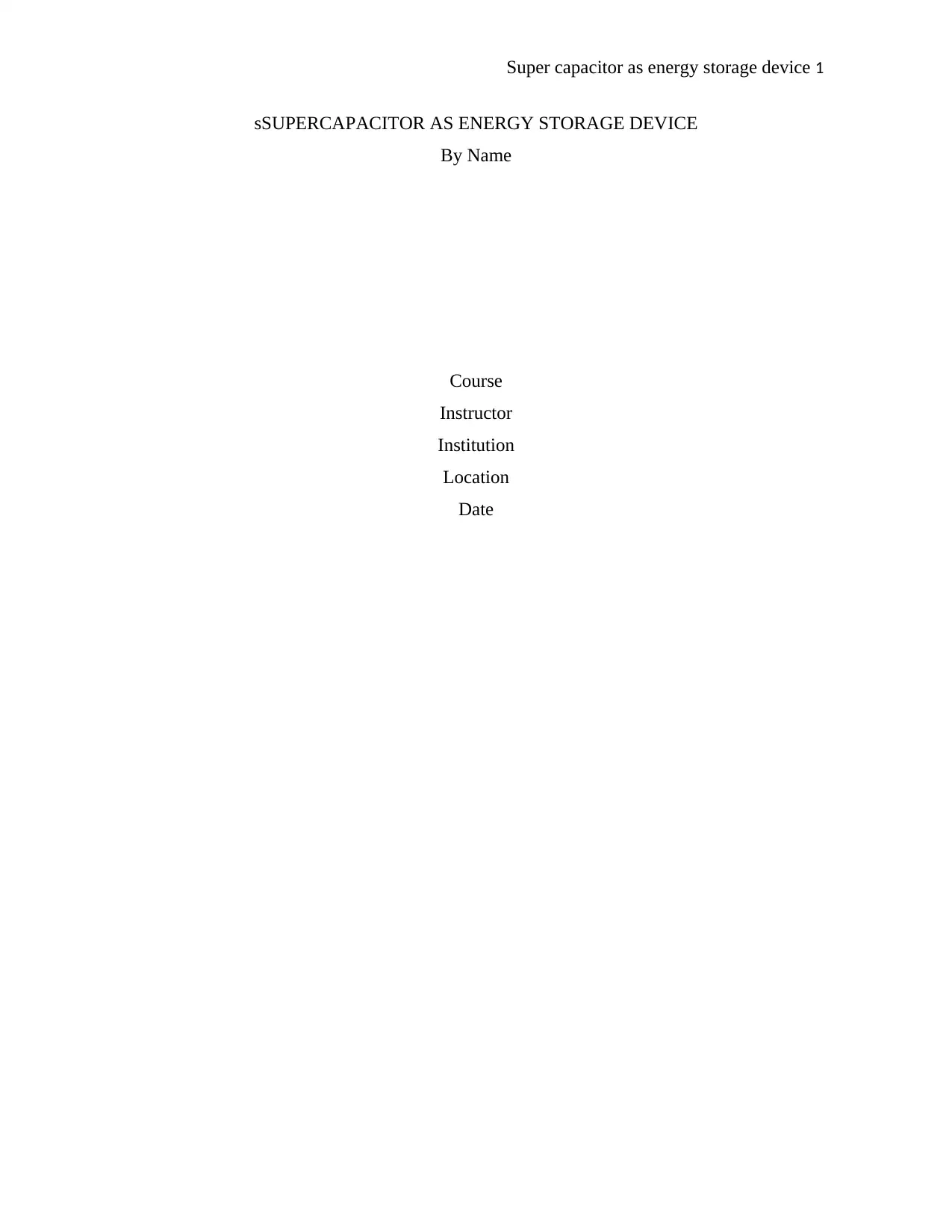
Super capacitor as energy storage device 1
sSUPERCAPACITOR AS ENERGY STORAGE DEVICE
By Name
Course
Instructor
Institution
Location
Date
sSUPERCAPACITOR AS ENERGY STORAGE DEVICE
By Name
Course
Instructor
Institution
Location
Date
Paraphrase This Document
Need a fresh take? Get an instant paraphrase of this document with our AI Paraphraser

Super capacitor as energy storage device 2
ABSTRACT
The power generated from the renewable sources of energy like wind is variable in
nature and in most cases it contains unaccepted serious fluctuations of the electrical energy
generated. This serious bottleneck is alleviated by using energy storage device system. And for
so many years battery has been employed to do this storage. Nonetheless, the cost of these
batteries, limited lifespan, and lower storage capacity has been a great concern to them. To help
solve these problems of this battery, a supercapacitor storage device is used (Kularatna, 2014). In
this paper, we will basically discuss on how supercapacitor is employed in the storage of
electrical energy as well as why it is employed in the storage of electrical energy.
This research paper will illustrate how this supercapacitor is employed in on-grid power
generated by solar PV system for the storage. This storage device stores electrical energy for a
relatively long time as compared to the normal battery. Energy obtained from PV panels are
basically irregular sustainable electrical energy hence for a good and continuous supply of
electrical energy supercapacitor which stores more electrical energy will be required (Zhang,
2012). And in the remote areas which area which is far from the national grid a standalone
Photovoltaic system is employed.
These Super Capacitors are connected to the Photovoltaic panels which enable the
storage of electrical energy immediately after the generation (Peng, 2015). This is employed to
avoid the electrical energy which would have been wasted if not used at the point of the
generation. And it also helps to ensure that there is a continuous supply of electrical energy even
during that time with less illumination of radiation ( (Frackowiak, 2013)).
ABSTRACT
The power generated from the renewable sources of energy like wind is variable in
nature and in most cases it contains unaccepted serious fluctuations of the electrical energy
generated. This serious bottleneck is alleviated by using energy storage device system. And for
so many years battery has been employed to do this storage. Nonetheless, the cost of these
batteries, limited lifespan, and lower storage capacity has been a great concern to them. To help
solve these problems of this battery, a supercapacitor storage device is used (Kularatna, 2014). In
this paper, we will basically discuss on how supercapacitor is employed in the storage of
electrical energy as well as why it is employed in the storage of electrical energy.
This research paper will illustrate how this supercapacitor is employed in on-grid power
generated by solar PV system for the storage. This storage device stores electrical energy for a
relatively long time as compared to the normal battery. Energy obtained from PV panels are
basically irregular sustainable electrical energy hence for a good and continuous supply of
electrical energy supercapacitor which stores more electrical energy will be required (Zhang,
2012). And in the remote areas which area which is far from the national grid a standalone
Photovoltaic system is employed.
These Super Capacitors are connected to the Photovoltaic panels which enable the
storage of electrical energy immediately after the generation (Peng, 2015). This is employed to
avoid the electrical energy which would have been wasted if not used at the point of the
generation. And it also helps to ensure that there is a continuous supply of electrical energy even
during that time with less illumination of radiation ( (Frackowiak, 2013)).
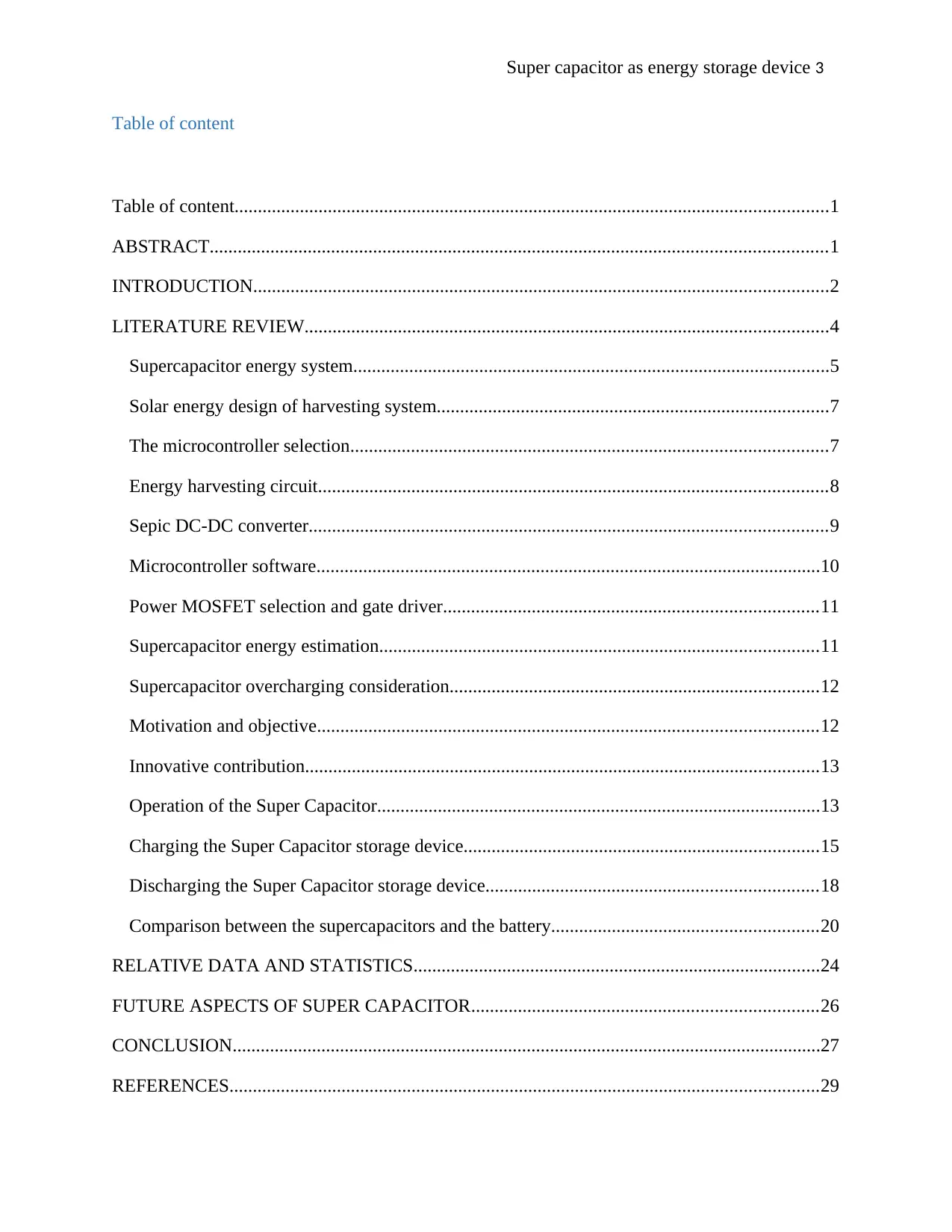
Super capacitor as energy storage device 3
Table of content
Table of content...............................................................................................................................1
ABSTRACT....................................................................................................................................1
INTRODUCTION...........................................................................................................................2
LITERATURE REVIEW................................................................................................................4
Supercapacitor energy system......................................................................................................5
Solar energy design of harvesting system....................................................................................7
The microcontroller selection......................................................................................................7
Energy harvesting circuit.............................................................................................................8
Sepic DC-DC converter...............................................................................................................9
Microcontroller software............................................................................................................10
Power MOSFET selection and gate driver................................................................................11
Supercapacitor energy estimation..............................................................................................11
Supercapacitor overcharging consideration...............................................................................12
Motivation and objective...........................................................................................................12
Innovative contribution..............................................................................................................13
Operation of the Super Capacitor...............................................................................................13
Charging the Super Capacitor storage device............................................................................15
Discharging the Super Capacitor storage device.......................................................................18
Comparison between the supercapacitors and the battery.........................................................20
RELATIVE DATA AND STATISTICS.......................................................................................24
FUTURE ASPECTS OF SUPER CAPACITOR..........................................................................26
CONCLUSION..............................................................................................................................27
REFERENCES..............................................................................................................................29
Table of content
Table of content...............................................................................................................................1
ABSTRACT....................................................................................................................................1
INTRODUCTION...........................................................................................................................2
LITERATURE REVIEW................................................................................................................4
Supercapacitor energy system......................................................................................................5
Solar energy design of harvesting system....................................................................................7
The microcontroller selection......................................................................................................7
Energy harvesting circuit.............................................................................................................8
Sepic DC-DC converter...............................................................................................................9
Microcontroller software............................................................................................................10
Power MOSFET selection and gate driver................................................................................11
Supercapacitor energy estimation..............................................................................................11
Supercapacitor overcharging consideration...............................................................................12
Motivation and objective...........................................................................................................12
Innovative contribution..............................................................................................................13
Operation of the Super Capacitor...............................................................................................13
Charging the Super Capacitor storage device............................................................................15
Discharging the Super Capacitor storage device.......................................................................18
Comparison between the supercapacitors and the battery.........................................................20
RELATIVE DATA AND STATISTICS.......................................................................................24
FUTURE ASPECTS OF SUPER CAPACITOR..........................................................................26
CONCLUSION..............................................................................................................................27
REFERENCES..............................................................................................................................29
⊘ This is a preview!⊘
Do you want full access?
Subscribe today to unlock all pages.

Trusted by 1+ million students worldwide
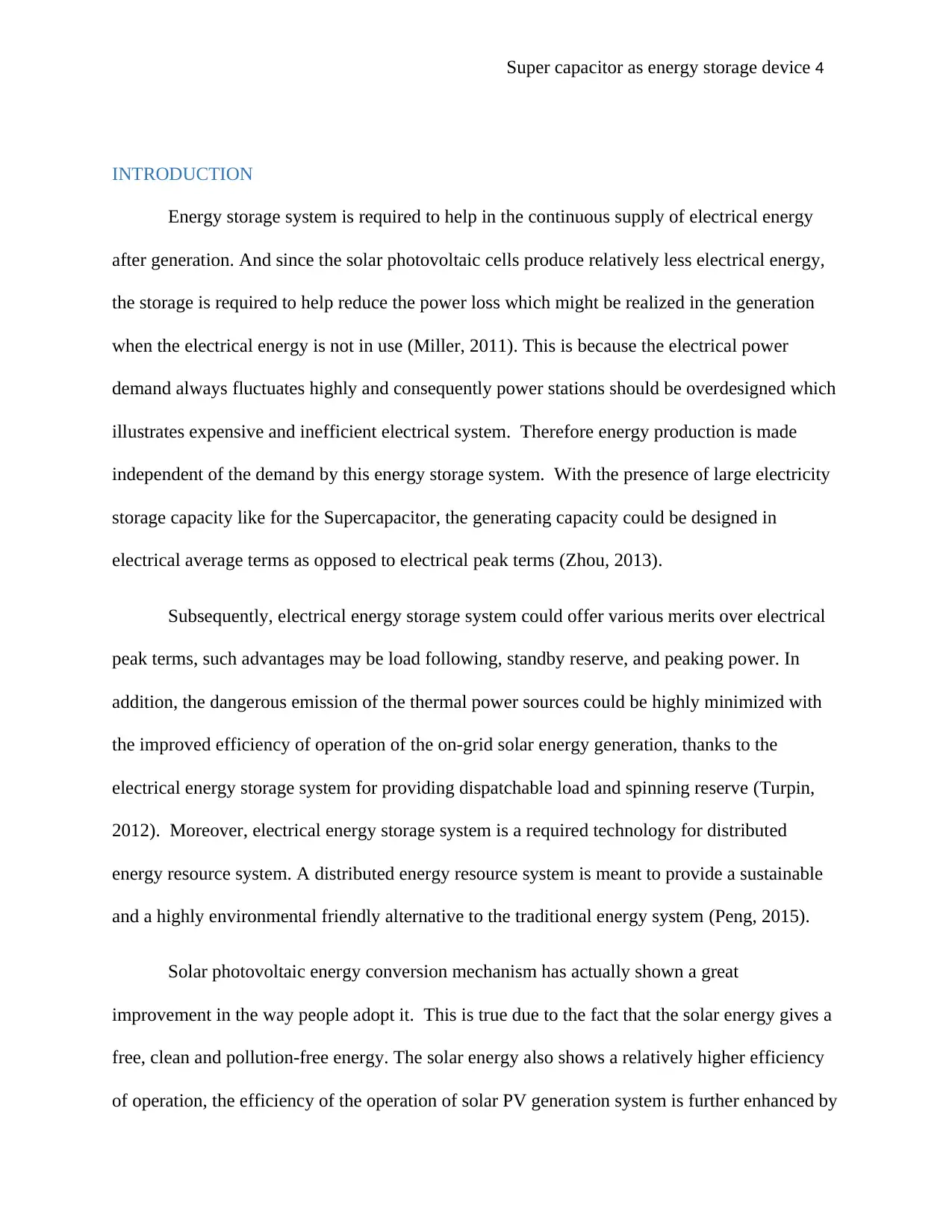
Super capacitor as energy storage device 4
INTRODUCTION
Energy storage system is required to help in the continuous supply of electrical energy
after generation. And since the solar photovoltaic cells produce relatively less electrical energy,
the storage is required to help reduce the power loss which might be realized in the generation
when the electrical energy is not in use (Miller, 2011). This is because the electrical power
demand always fluctuates highly and consequently power stations should be overdesigned which
illustrates expensive and inefficient electrical system. Therefore energy production is made
independent of the demand by this energy storage system. With the presence of large electricity
storage capacity like for the Supercapacitor, the generating capacity could be designed in
electrical average terms as opposed to electrical peak terms (Zhou, 2013).
Subsequently, electrical energy storage system could offer various merits over electrical
peak terms, such advantages may be load following, standby reserve, and peaking power. In
addition, the dangerous emission of the thermal power sources could be highly minimized with
the improved efficiency of operation of the on-grid solar energy generation, thanks to the
electrical energy storage system for providing dispatchable load and spinning reserve (Turpin,
2012). Moreover, electrical energy storage system is a required technology for distributed
energy resource system. A distributed energy resource system is meant to provide a sustainable
and a highly environmental friendly alternative to the traditional energy system (Peng, 2015).
Solar photovoltaic energy conversion mechanism has actually shown a great
improvement in the way people adopt it. This is true due to the fact that the solar energy gives a
free, clean and pollution-free energy. The solar energy also shows a relatively higher efficiency
of operation, the efficiency of the operation of solar PV generation system is further enhanced by
INTRODUCTION
Energy storage system is required to help in the continuous supply of electrical energy
after generation. And since the solar photovoltaic cells produce relatively less electrical energy,
the storage is required to help reduce the power loss which might be realized in the generation
when the electrical energy is not in use (Miller, 2011). This is because the electrical power
demand always fluctuates highly and consequently power stations should be overdesigned which
illustrates expensive and inefficient electrical system. Therefore energy production is made
independent of the demand by this energy storage system. With the presence of large electricity
storage capacity like for the Supercapacitor, the generating capacity could be designed in
electrical average terms as opposed to electrical peak terms (Zhou, 2013).
Subsequently, electrical energy storage system could offer various merits over electrical
peak terms, such advantages may be load following, standby reserve, and peaking power. In
addition, the dangerous emission of the thermal power sources could be highly minimized with
the improved efficiency of operation of the on-grid solar energy generation, thanks to the
electrical energy storage system for providing dispatchable load and spinning reserve (Turpin,
2012). Moreover, electrical energy storage system is a required technology for distributed
energy resource system. A distributed energy resource system is meant to provide a sustainable
and a highly environmental friendly alternative to the traditional energy system (Peng, 2015).
Solar photovoltaic energy conversion mechanism has actually shown a great
improvement in the way people adopt it. This is true due to the fact that the solar energy gives a
free, clean and pollution-free energy. The solar energy also shows a relatively higher efficiency
of operation, the efficiency of the operation of solar PV generation system is further enhanced by
Paraphrase This Document
Need a fresh take? Get an instant paraphrase of this document with our AI Paraphraser
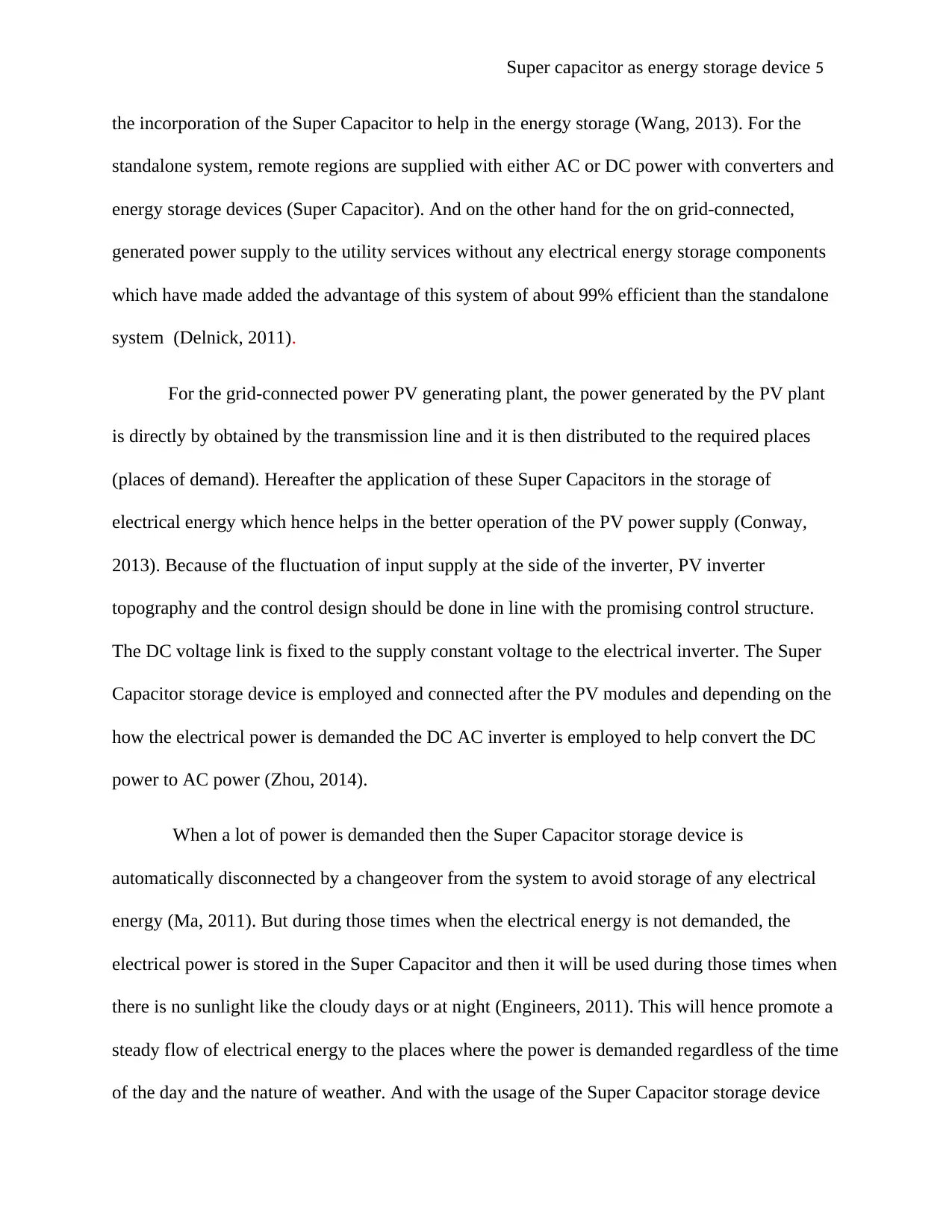
Super capacitor as energy storage device 5
the incorporation of the Super Capacitor to help in the energy storage (Wang, 2013). For the
standalone system, remote regions are supplied with either AC or DC power with converters and
energy storage devices (Super Capacitor). And on the other hand for the on grid-connected,
generated power supply to the utility services without any electrical energy storage components
which have made added the advantage of this system of about 99% efficient than the standalone
system (Delnick, 2011).
For the grid-connected power PV generating plant, the power generated by the PV plant
is directly by obtained by the transmission line and it is then distributed to the required places
(places of demand). Hereafter the application of these Super Capacitors in the storage of
electrical energy which hence helps in the better operation of the PV power supply (Conway,
2013). Because of the fluctuation of input supply at the side of the inverter, PV inverter
topography and the control design should be done in line with the promising control structure.
The DC voltage link is fixed to the supply constant voltage to the electrical inverter. The Super
Capacitor storage device is employed and connected after the PV modules and depending on the
how the electrical power is demanded the DC AC inverter is employed to help convert the DC
power to AC power (Zhou, 2014).
When a lot of power is demanded then the Super Capacitor storage device is
automatically disconnected by a changeover from the system to avoid storage of any electrical
energy (Ma, 2011). But during those times when the electrical energy is not demanded, the
electrical power is stored in the Super Capacitor and then it will be used during those times when
there is no sunlight like the cloudy days or at night (Engineers, 2011). This will hence promote a
steady flow of electrical energy to the places where the power is demanded regardless of the time
of the day and the nature of weather. And with the usage of the Super Capacitor storage device
the incorporation of the Super Capacitor to help in the energy storage (Wang, 2013). For the
standalone system, remote regions are supplied with either AC or DC power with converters and
energy storage devices (Super Capacitor). And on the other hand for the on grid-connected,
generated power supply to the utility services without any electrical energy storage components
which have made added the advantage of this system of about 99% efficient than the standalone
system (Delnick, 2011).
For the grid-connected power PV generating plant, the power generated by the PV plant
is directly by obtained by the transmission line and it is then distributed to the required places
(places of demand). Hereafter the application of these Super Capacitors in the storage of
electrical energy which hence helps in the better operation of the PV power supply (Conway,
2013). Because of the fluctuation of input supply at the side of the inverter, PV inverter
topography and the control design should be done in line with the promising control structure.
The DC voltage link is fixed to the supply constant voltage to the electrical inverter. The Super
Capacitor storage device is employed and connected after the PV modules and depending on the
how the electrical power is demanded the DC AC inverter is employed to help convert the DC
power to AC power (Zhou, 2014).
When a lot of power is demanded then the Super Capacitor storage device is
automatically disconnected by a changeover from the system to avoid storage of any electrical
energy (Ma, 2011). But during those times when the electrical energy is not demanded, the
electrical power is stored in the Super Capacitor and then it will be used during those times when
there is no sunlight like the cloudy days or at night (Engineers, 2011). This will hence promote a
steady flow of electrical energy to the places where the power is demanded regardless of the time
of the day and the nature of weather. And with the usage of the Super Capacitor storage device
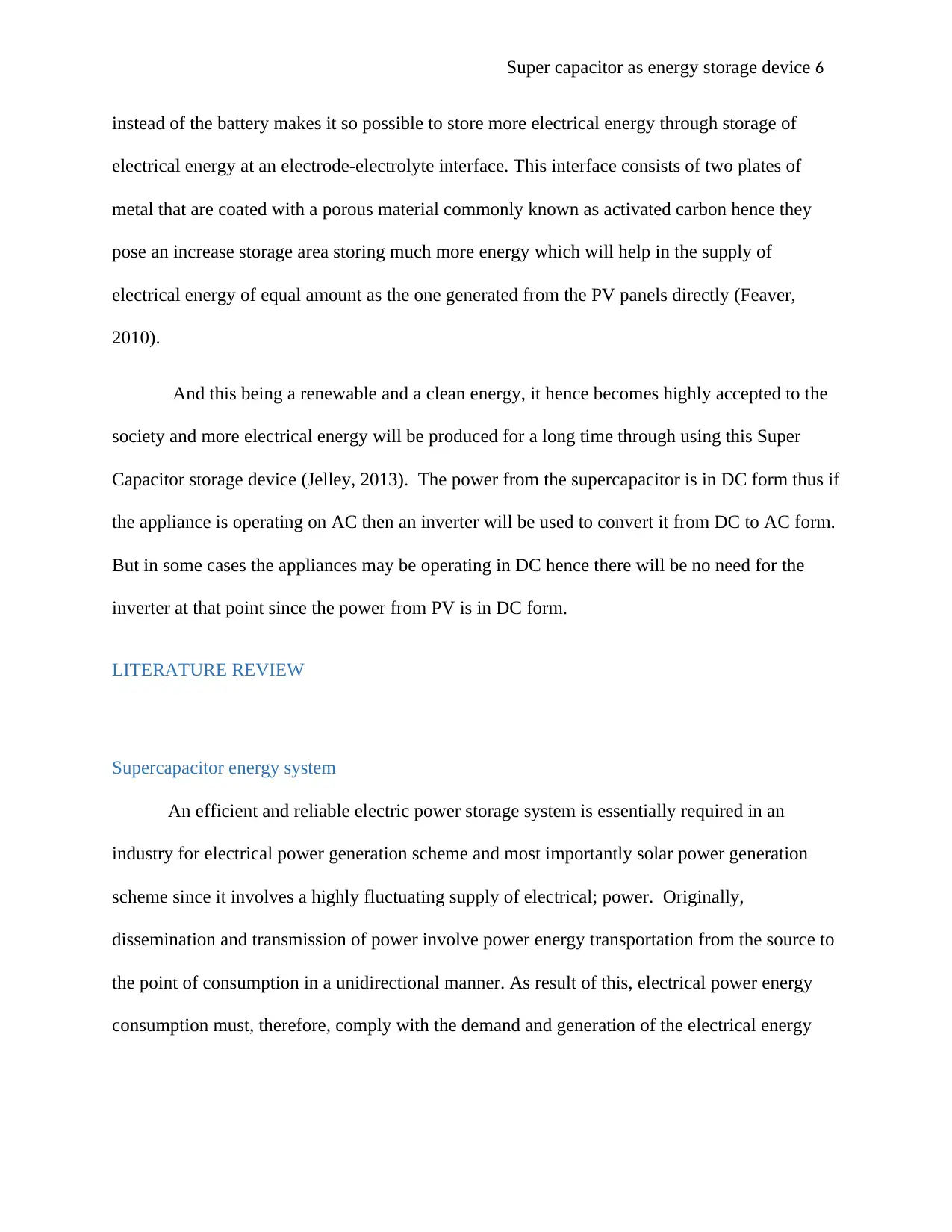
Super capacitor as energy storage device 6
instead of the battery makes it so possible to store more electrical energy through storage of
electrical energy at an electrode-electrolyte interface. This interface consists of two plates of
metal that are coated with a porous material commonly known as activated carbon hence they
pose an increase storage area storing much more energy which will help in the supply of
electrical energy of equal amount as the one generated from the PV panels directly (Feaver,
2010).
And this being a renewable and a clean energy, it hence becomes highly accepted to the
society and more electrical energy will be produced for a long time through using this Super
Capacitor storage device (Jelley, 2013). The power from the supercapacitor is in DC form thus if
the appliance is operating on AC then an inverter will be used to convert it from DC to AC form.
But in some cases the appliances may be operating in DC hence there will be no need for the
inverter at that point since the power from PV is in DC form.
LITERATURE REVIEW
Supercapacitor energy system
An efficient and reliable electric power storage system is essentially required in an
industry for electrical power generation scheme and most importantly solar power generation
scheme since it involves a highly fluctuating supply of electrical; power. Originally,
dissemination and transmission of power involve power energy transportation from the source to
the point of consumption in a unidirectional manner. As result of this, electrical power energy
consumption must, therefore, comply with the demand and generation of the electrical energy
instead of the battery makes it so possible to store more electrical energy through storage of
electrical energy at an electrode-electrolyte interface. This interface consists of two plates of
metal that are coated with a porous material commonly known as activated carbon hence they
pose an increase storage area storing much more energy which will help in the supply of
electrical energy of equal amount as the one generated from the PV panels directly (Feaver,
2010).
And this being a renewable and a clean energy, it hence becomes highly accepted to the
society and more electrical energy will be produced for a long time through using this Super
Capacitor storage device (Jelley, 2013). The power from the supercapacitor is in DC form thus if
the appliance is operating on AC then an inverter will be used to convert it from DC to AC form.
But in some cases the appliances may be operating in DC hence there will be no need for the
inverter at that point since the power from PV is in DC form.
LITERATURE REVIEW
Supercapacitor energy system
An efficient and reliable electric power storage system is essentially required in an
industry for electrical power generation scheme and most importantly solar power generation
scheme since it involves a highly fluctuating supply of electrical; power. Originally,
dissemination and transmission of power involve power energy transportation from the source to
the point of consumption in a unidirectional manner. As result of this, electrical power energy
consumption must, therefore, comply with the demand and generation of the electrical energy
⊘ This is a preview!⊘
Do you want full access?
Subscribe today to unlock all pages.

Trusted by 1+ million students worldwide

Super capacitor as energy storage device 7
though, in contradiction, power demand constantly fluctuate leading adjustments in the design of
power plants to meet the inconsistent demands from the consumer (Srinivasan, 2010).
In the recent past, photovoltaic cells became more popular in increasing the independence
of systems which are embedded. The output features and reliability of photovoltaic cells differs
none uniformly in relation to the prevailing environmental conditions which includes
temperature and irradiations (Zheng, 2012). In addition, power obtained or sourced from this cell
dominantly rely on its point of operation for example when demanding sufficient energy
amounts and quantity, it is maintained at its maximum operating point. Photovoltaic terminal
voltage always falls to a negligible value whenever a high current is demanded from it whereas
whenever there is no or limited demand of current from the cell, there is an increase in its
terminal voltage towards the open circuit voltage (Krauter, 2012). In conclusion, there is no
generation of power at both extreme scenarios of the photovoltaic cell hence the urgency for
coming up with an algorithm maintaining the cell at its optimum power point also known as
power point tracking methods.
Production of electrical energy in solar energy plants has been made reliable through use of
supercapacitors as an energy storage system instead of the battery due to its high capability of
storing and efficiently disseminating power when required (Hoffmann, 2015). Due to large-scale
storage capabilities of supercapacitors, generating a quantity of power in average electrical terms
instead peak demand levels. In solving the highly varying and inconsistent source of energy in
solar energy production, batteries are replaced with supercapacitors which facilitate power input
and output cycles in a reduced amount of time of approximately 10 seconds thus charge and
discharge cycles are made inferior (Gevorkian, 2012). Operation of supercapacitors is majorly
though, in contradiction, power demand constantly fluctuate leading adjustments in the design of
power plants to meet the inconsistent demands from the consumer (Srinivasan, 2010).
In the recent past, photovoltaic cells became more popular in increasing the independence
of systems which are embedded. The output features and reliability of photovoltaic cells differs
none uniformly in relation to the prevailing environmental conditions which includes
temperature and irradiations (Zheng, 2012). In addition, power obtained or sourced from this cell
dominantly rely on its point of operation for example when demanding sufficient energy
amounts and quantity, it is maintained at its maximum operating point. Photovoltaic terminal
voltage always falls to a negligible value whenever a high current is demanded from it whereas
whenever there is no or limited demand of current from the cell, there is an increase in its
terminal voltage towards the open circuit voltage (Krauter, 2012). In conclusion, there is no
generation of power at both extreme scenarios of the photovoltaic cell hence the urgency for
coming up with an algorithm maintaining the cell at its optimum power point also known as
power point tracking methods.
Production of electrical energy in solar energy plants has been made reliable through use of
supercapacitors as an energy storage system instead of the battery due to its high capability of
storing and efficiently disseminating power when required (Hoffmann, 2015). Due to large-scale
storage capabilities of supercapacitors, generating a quantity of power in average electrical terms
instead peak demand levels. In solving the highly varying and inconsistent source of energy in
solar energy production, batteries are replaced with supercapacitors which facilitate power input
and output cycles in a reduced amount of time of approximately 10 seconds thus charge and
discharge cycles are made inferior (Gevorkian, 2012). Operation of supercapacitors is majorly
Paraphrase This Document
Need a fresh take? Get an instant paraphrase of this document with our AI Paraphraser
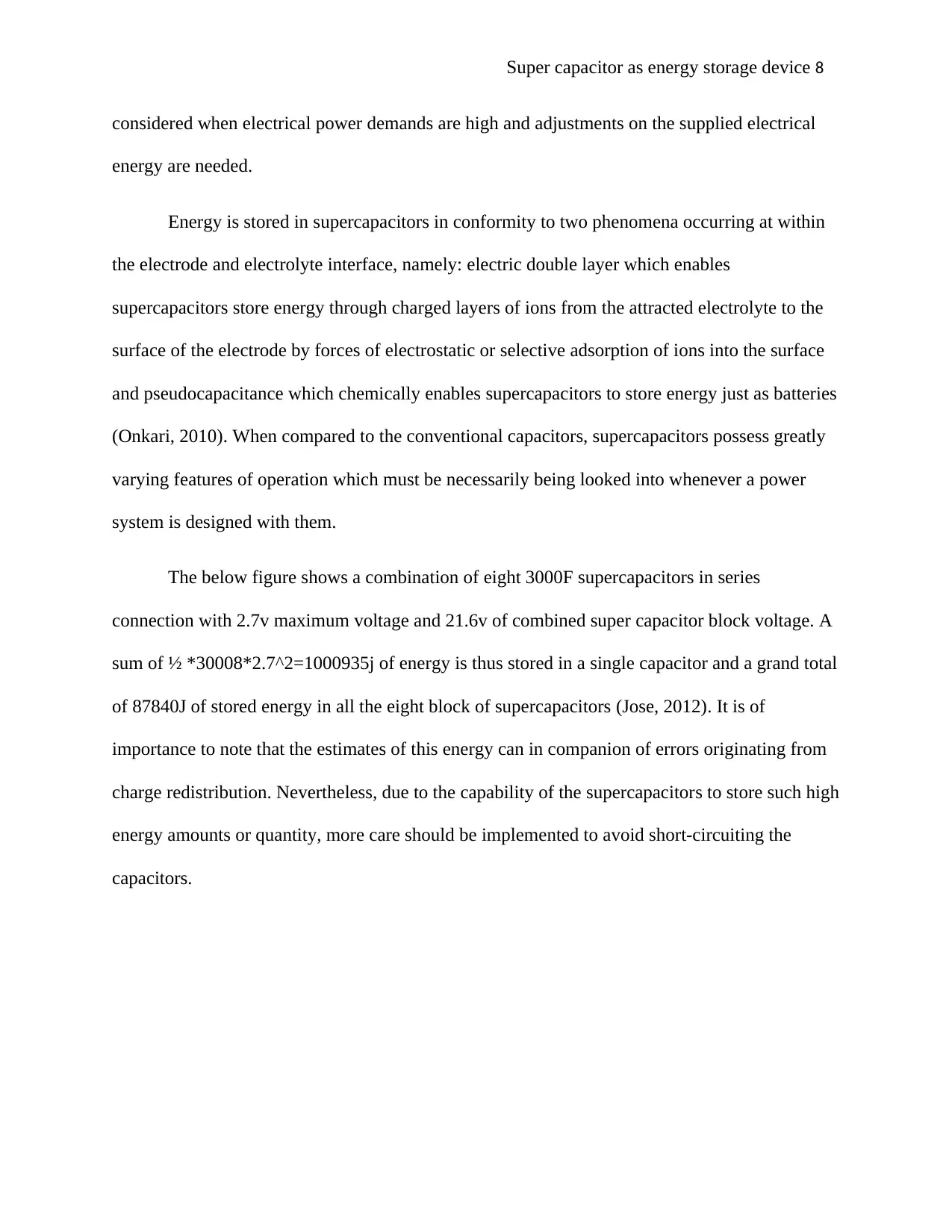
Super capacitor as energy storage device 8
considered when electrical power demands are high and adjustments on the supplied electrical
energy are needed.
Energy is stored in supercapacitors in conformity to two phenomena occurring at within
the electrode and electrolyte interface, namely: electric double layer which enables
supercapacitors store energy through charged layers of ions from the attracted electrolyte to the
surface of the electrode by forces of electrostatic or selective adsorption of ions into the surface
and pseudocapacitance which chemically enables supercapacitors to store energy just as batteries
(Onkari, 2010). When compared to the conventional capacitors, supercapacitors possess greatly
varying features of operation which must be necessarily being looked into whenever a power
system is designed with them.
The below figure shows a combination of eight 3000F supercapacitors in series
connection with 2.7v maximum voltage and 21.6v of combined super capacitor block voltage. A
sum of ½ *30008*2.7^2=1000935j of energy is thus stored in a single capacitor and a grand total
of 87840J of stored energy in all the eight block of supercapacitors (Jose, 2012). It is of
importance to note that the estimates of this energy can in companion of errors originating from
charge redistribution. Nevertheless, due to the capability of the supercapacitors to store such high
energy amounts or quantity, more care should be implemented to avoid short-circuiting the
capacitors.
considered when electrical power demands are high and adjustments on the supplied electrical
energy are needed.
Energy is stored in supercapacitors in conformity to two phenomena occurring at within
the electrode and electrolyte interface, namely: electric double layer which enables
supercapacitors store energy through charged layers of ions from the attracted electrolyte to the
surface of the electrode by forces of electrostatic or selective adsorption of ions into the surface
and pseudocapacitance which chemically enables supercapacitors to store energy just as batteries
(Onkari, 2010). When compared to the conventional capacitors, supercapacitors possess greatly
varying features of operation which must be necessarily being looked into whenever a power
system is designed with them.
The below figure shows a combination of eight 3000F supercapacitors in series
connection with 2.7v maximum voltage and 21.6v of combined super capacitor block voltage. A
sum of ½ *30008*2.7^2=1000935j of energy is thus stored in a single capacitor and a grand total
of 87840J of stored energy in all the eight block of supercapacitors (Jose, 2012). It is of
importance to note that the estimates of this energy can in companion of errors originating from
charge redistribution. Nevertheless, due to the capability of the supercapacitors to store such high
energy amounts or quantity, more care should be implemented to avoid short-circuiting the
capacitors.
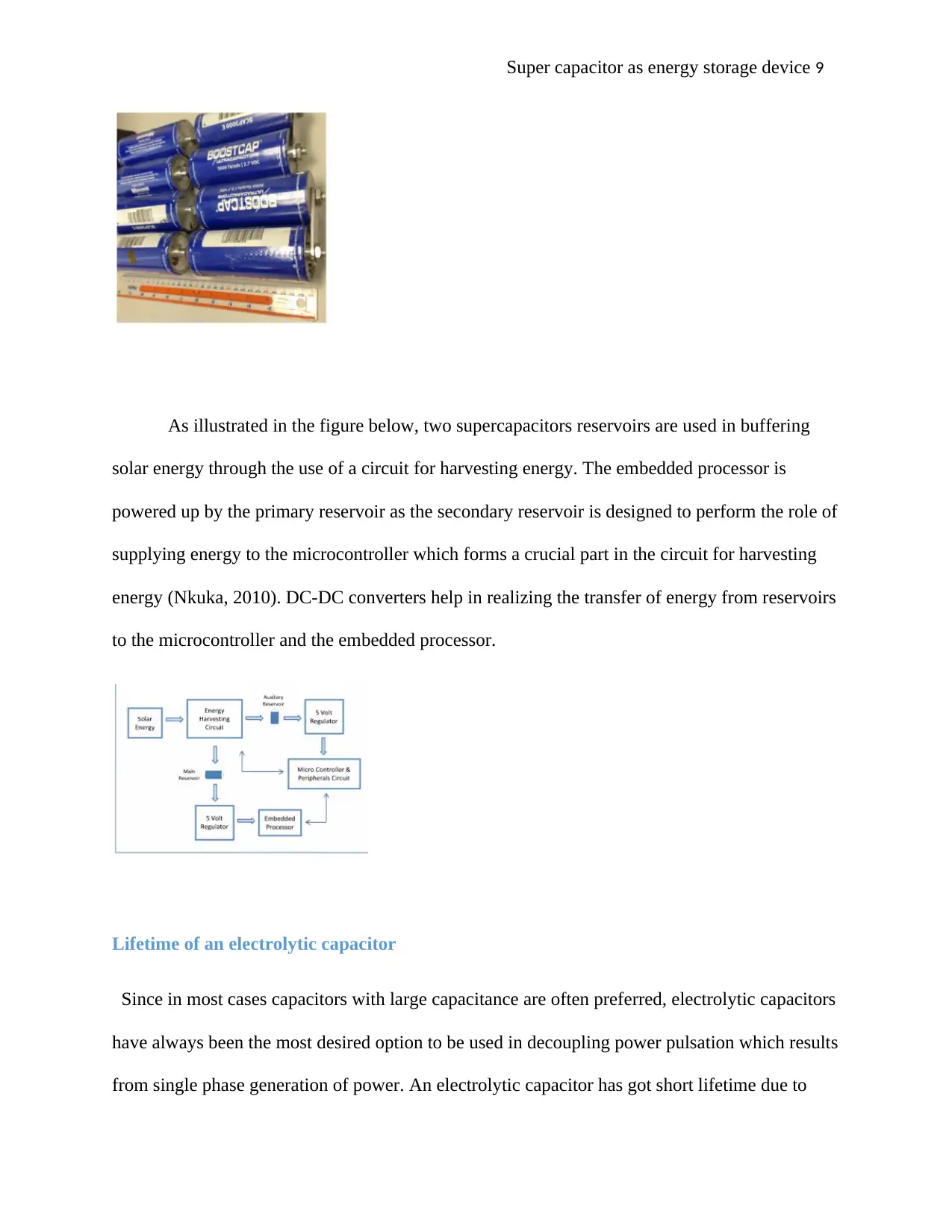
Super capacitor as energy storage device 9
As illustrated in the figure below, two supercapacitors reservoirs are used in buffering
solar energy through the use of a circuit for harvesting energy. The embedded processor is
powered up by the primary reservoir as the secondary reservoir is designed to perform the role of
supplying energy to the microcontroller which forms a crucial part in the circuit for harvesting
energy (Nkuka, 2010). DC-DC converters help in realizing the transfer of energy from reservoirs
to the microcontroller and the embedded processor.
Lifetime of an electrolytic capacitor
Since in most cases capacitors with large capacitance are often preferred, electrolytic capacitors
have always been the most desired option to be used in decoupling power pulsation which results
from single phase generation of power. An electrolytic capacitor has got short lifetime due to
As illustrated in the figure below, two supercapacitors reservoirs are used in buffering
solar energy through the use of a circuit for harvesting energy. The embedded processor is
powered up by the primary reservoir as the secondary reservoir is designed to perform the role of
supplying energy to the microcontroller which forms a crucial part in the circuit for harvesting
energy (Nkuka, 2010). DC-DC converters help in realizing the transfer of energy from reservoirs
to the microcontroller and the embedded processor.
Lifetime of an electrolytic capacitor
Since in most cases capacitors with large capacitance are often preferred, electrolytic capacitors
have always been the most desired option to be used in decoupling power pulsation which results
from single phase generation of power. An electrolytic capacitor has got short lifetime due to
⊘ This is a preview!⊘
Do you want full access?
Subscribe today to unlock all pages.

Trusted by 1+ million students worldwide
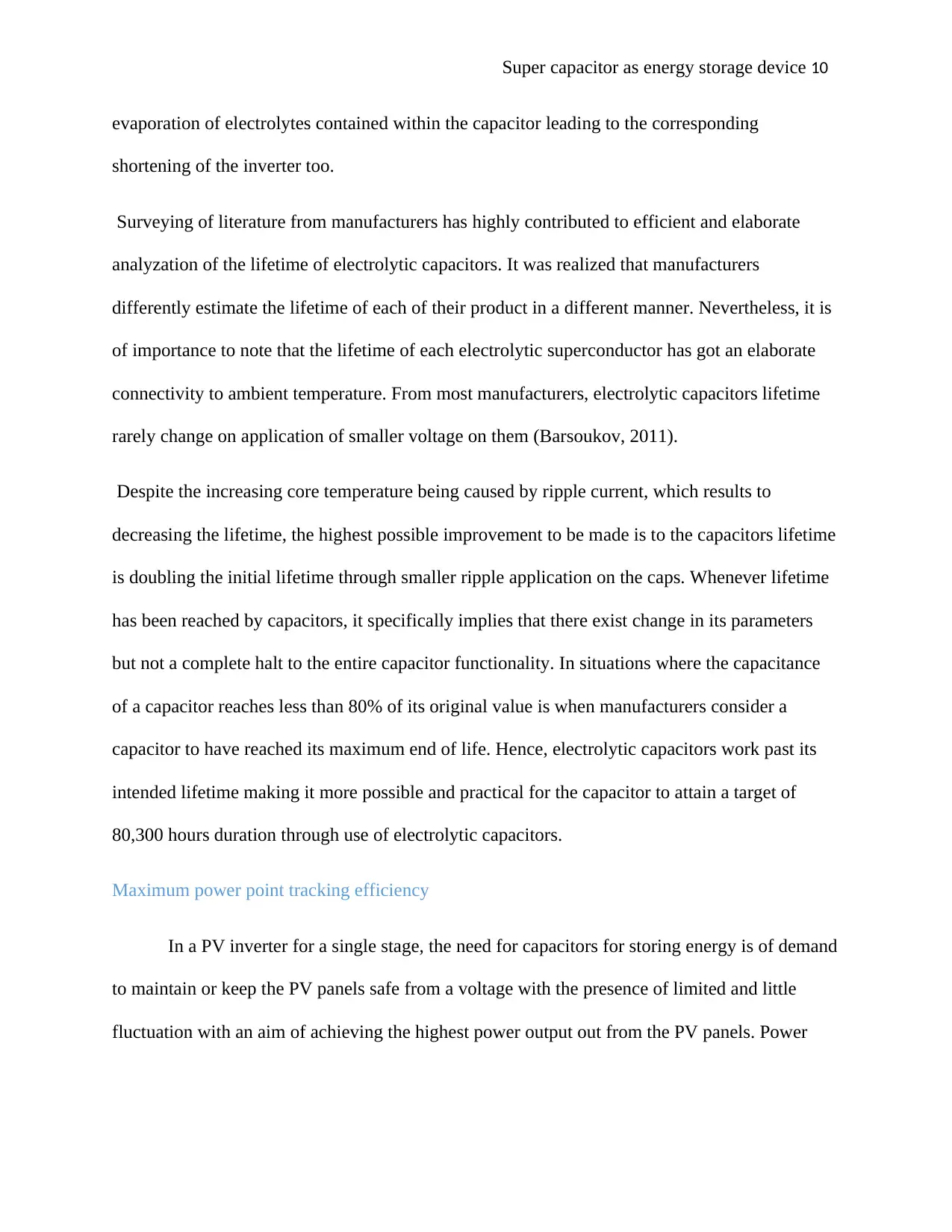
Super capacitor as energy storage device 10
evaporation of electrolytes contained within the capacitor leading to the corresponding
shortening of the inverter too.
Surveying of literature from manufacturers has highly contributed to efficient and elaborate
analyzation of the lifetime of electrolytic capacitors. It was realized that manufacturers
differently estimate the lifetime of each of their product in a different manner. Nevertheless, it is
of importance to note that the lifetime of each electrolytic superconductor has got an elaborate
connectivity to ambient temperature. From most manufacturers, electrolytic capacitors lifetime
rarely change on application of smaller voltage on them (Barsoukov, 2011).
Despite the increasing core temperature being caused by ripple current, which results to
decreasing the lifetime, the highest possible improvement to be made is to the capacitors lifetime
is doubling the initial lifetime through smaller ripple application on the caps. Whenever lifetime
has been reached by capacitors, it specifically implies that there exist change in its parameters
but not a complete halt to the entire capacitor functionality. In situations where the capacitance
of a capacitor reaches less than 80% of its original value is when manufacturers consider a
capacitor to have reached its maximum end of life. Hence, electrolytic capacitors work past its
intended lifetime making it more possible and practical for the capacitor to attain a target of
80,300 hours duration through use of electrolytic capacitors.
Maximum power point tracking efficiency
In a PV inverter for a single stage, the need for capacitors for storing energy is of demand
to maintain or keep the PV panels safe from a voltage with the presence of limited and little
fluctuation with an aim of achieving the highest power output out from the PV panels. Power
evaporation of electrolytes contained within the capacitor leading to the corresponding
shortening of the inverter too.
Surveying of literature from manufacturers has highly contributed to efficient and elaborate
analyzation of the lifetime of electrolytic capacitors. It was realized that manufacturers
differently estimate the lifetime of each of their product in a different manner. Nevertheless, it is
of importance to note that the lifetime of each electrolytic superconductor has got an elaborate
connectivity to ambient temperature. From most manufacturers, electrolytic capacitors lifetime
rarely change on application of smaller voltage on them (Barsoukov, 2011).
Despite the increasing core temperature being caused by ripple current, which results to
decreasing the lifetime, the highest possible improvement to be made is to the capacitors lifetime
is doubling the initial lifetime through smaller ripple application on the caps. Whenever lifetime
has been reached by capacitors, it specifically implies that there exist change in its parameters
but not a complete halt to the entire capacitor functionality. In situations where the capacitance
of a capacitor reaches less than 80% of its original value is when manufacturers consider a
capacitor to have reached its maximum end of life. Hence, electrolytic capacitors work past its
intended lifetime making it more possible and practical for the capacitor to attain a target of
80,300 hours duration through use of electrolytic capacitors.
Maximum power point tracking efficiency
In a PV inverter for a single stage, the need for capacitors for storing energy is of demand
to maintain or keep the PV panels safe from a voltage with the presence of limited and little
fluctuation with an aim of achieving the highest power output out from the PV panels. Power
Paraphrase This Document
Need a fresh take? Get an instant paraphrase of this document with our AI Paraphraser
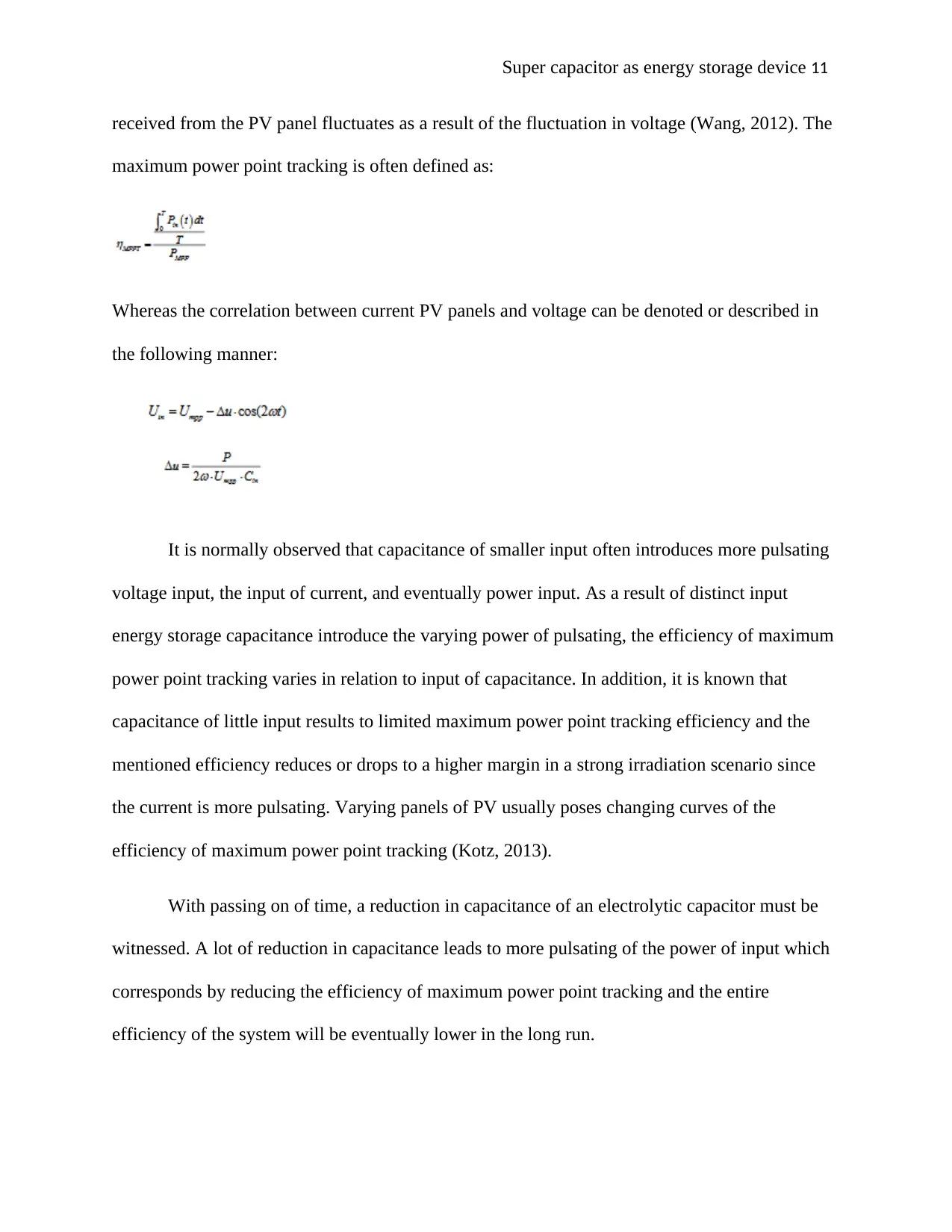
Super capacitor as energy storage device 11
received from the PV panel fluctuates as a result of the fluctuation in voltage (Wang, 2012). The
maximum power point tracking is often defined as:
Whereas the correlation between current PV panels and voltage can be denoted or described in
the following manner:
It is normally observed that capacitance of smaller input often introduces more pulsating
voltage input, the input of current, and eventually power input. As a result of distinct input
energy storage capacitance introduce the varying power of pulsating, the efficiency of maximum
power point tracking varies in relation to input of capacitance. In addition, it is known that
capacitance of little input results to limited maximum power point tracking efficiency and the
mentioned efficiency reduces or drops to a higher margin in a strong irradiation scenario since
the current is more pulsating. Varying panels of PV usually poses changing curves of the
efficiency of maximum power point tracking (Kotz, 2013).
With passing on of time, a reduction in capacitance of an electrolytic capacitor must be
witnessed. A lot of reduction in capacitance leads to more pulsating of the power of input which
corresponds by reducing the efficiency of maximum power point tracking and the entire
efficiency of the system will be eventually lower in the long run.
received from the PV panel fluctuates as a result of the fluctuation in voltage (Wang, 2012). The
maximum power point tracking is often defined as:
Whereas the correlation between current PV panels and voltage can be denoted or described in
the following manner:
It is normally observed that capacitance of smaller input often introduces more pulsating
voltage input, the input of current, and eventually power input. As a result of distinct input
energy storage capacitance introduce the varying power of pulsating, the efficiency of maximum
power point tracking varies in relation to input of capacitance. In addition, it is known that
capacitance of little input results to limited maximum power point tracking efficiency and the
mentioned efficiency reduces or drops to a higher margin in a strong irradiation scenario since
the current is more pulsating. Varying panels of PV usually poses changing curves of the
efficiency of maximum power point tracking (Kotz, 2013).
With passing on of time, a reduction in capacitance of an electrolytic capacitor must be
witnessed. A lot of reduction in capacitance leads to more pulsating of the power of input which
corresponds by reducing the efficiency of maximum power point tracking and the entire
efficiency of the system will be eventually lower in the long run.

Super capacitor as energy storage device 12
Supercapacitor energy estimation
Remaining energy in a supercapacitor is measured using a formula, 1/2CV^2 which
achieves accurate results when the capacitor is in a stable condition. Supercapacitors are different
from the normal conventional capacitors in that they contain numerous branches of resistance-
capacitance containing varying time constants. Accurate measurements are only attained
whenever all the available branches have reached stable conditions and absence of distribution of
charges between existing branches. Hence, when observing the voltage at the terminals in order
to come up with the remaining energy in a non-stable event, a close follow up on the state of
charge on the branches should be maintained. Lately, an approach was introduced known as
Kalman approach of filtering for estimating and coming up with the remaining energy contained
in a supercapacitor through terminal voltage observation and the sum of all available current
flowing through the supercapacitor (Sanz-Bobi, 2014).
Supercapacitor overcharging consideration
Experiments conducted on several super capacitors elaborated that manufacturing
acceptance ranging from 2855F to 3139F meant for Maxwell supercapacitors. Despite the
average being almost a reliable 3039F, there exists a tangible problem or challenge. In a situation
whereby the eight blocks of supercapacitors are operating at 21.6V, the specific current which
flows through them consistently charges the smallest supercapacitor to an increased voltage thus
achieving a 2.87V on the smallest and concurrently a 2.61V on the largest supercapacitor. In
general, it implies that as the smallest super capacitor experiences overcharge, the largest is
concurrently undercharged. A derived solution easy to implement is limiting the supercapacitor
block voltage (David, 2011).
Supercapacitor energy estimation
Remaining energy in a supercapacitor is measured using a formula, 1/2CV^2 which
achieves accurate results when the capacitor is in a stable condition. Supercapacitors are different
from the normal conventional capacitors in that they contain numerous branches of resistance-
capacitance containing varying time constants. Accurate measurements are only attained
whenever all the available branches have reached stable conditions and absence of distribution of
charges between existing branches. Hence, when observing the voltage at the terminals in order
to come up with the remaining energy in a non-stable event, a close follow up on the state of
charge on the branches should be maintained. Lately, an approach was introduced known as
Kalman approach of filtering for estimating and coming up with the remaining energy contained
in a supercapacitor through terminal voltage observation and the sum of all available current
flowing through the supercapacitor (Sanz-Bobi, 2014).
Supercapacitor overcharging consideration
Experiments conducted on several super capacitors elaborated that manufacturing
acceptance ranging from 2855F to 3139F meant for Maxwell supercapacitors. Despite the
average being almost a reliable 3039F, there exists a tangible problem or challenge. In a situation
whereby the eight blocks of supercapacitors are operating at 21.6V, the specific current which
flows through them consistently charges the smallest supercapacitor to an increased voltage thus
achieving a 2.87V on the smallest and concurrently a 2.61V on the largest supercapacitor. In
general, it implies that as the smallest super capacitor experiences overcharge, the largest is
concurrently undercharged. A derived solution easy to implement is limiting the supercapacitor
block voltage (David, 2011).
⊘ This is a preview!⊘
Do you want full access?
Subscribe today to unlock all pages.

Trusted by 1+ million students worldwide
1 out of 33
Related Documents
Your All-in-One AI-Powered Toolkit for Academic Success.
+13062052269
info@desklib.com
Available 24*7 on WhatsApp / Email
![[object Object]](/_next/static/media/star-bottom.7253800d.svg)
Unlock your academic potential
Copyright © 2020–2026 A2Z Services. All Rights Reserved. Developed and managed by ZUCOL.





